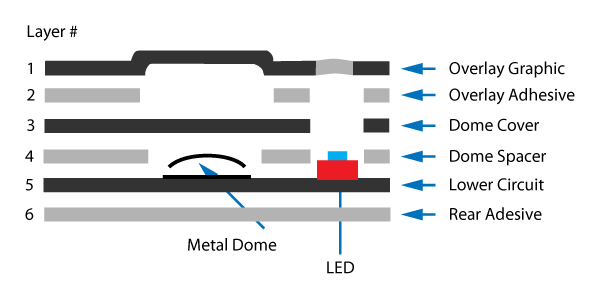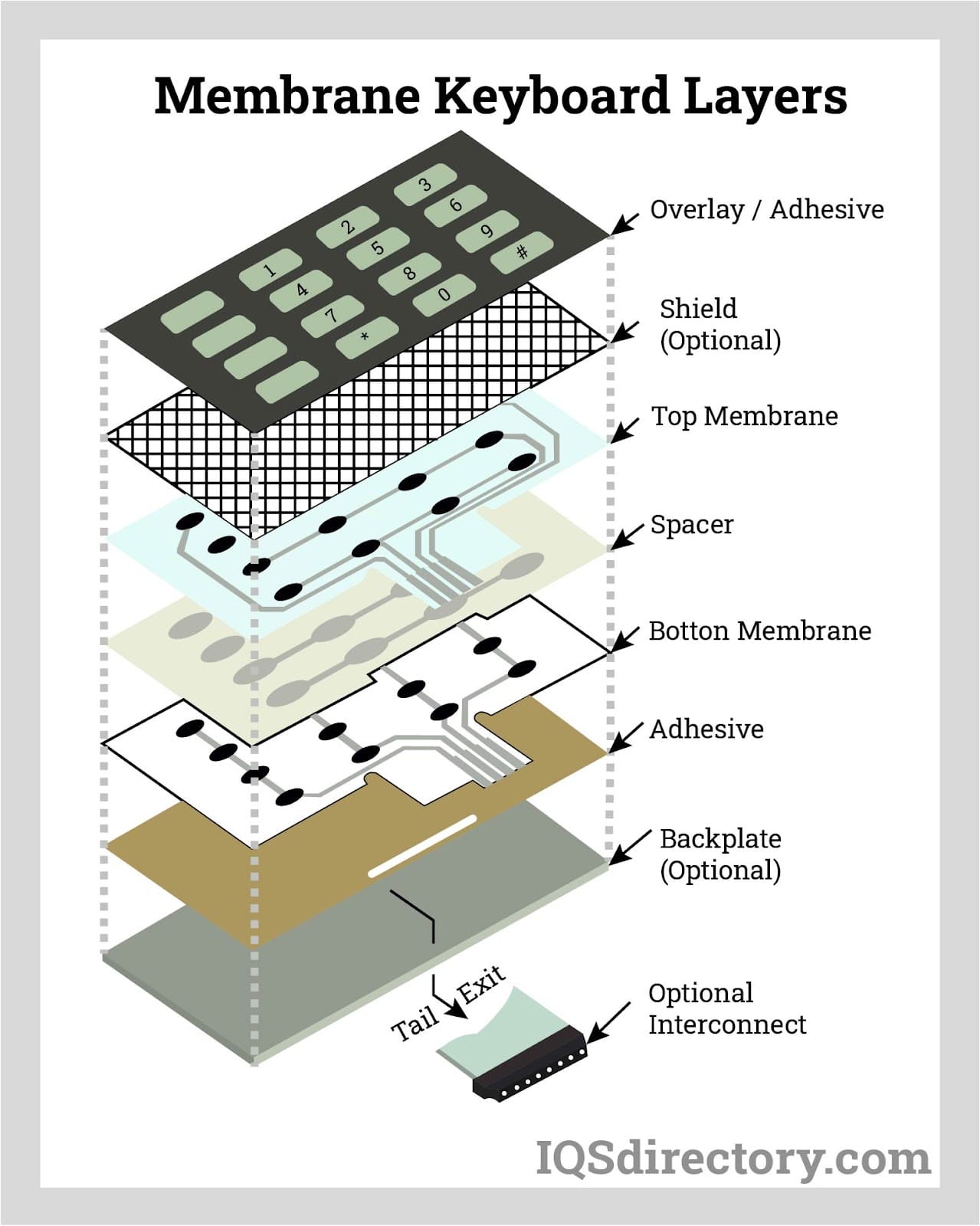Recognizing the Significance of Membrane Layer Switch in Modern Electronics
Membrane buttons are indispensable parts in contemporary digital devices. They provide a blend of capability and style that boosts user interaction. Their lightweight and resilient nature makes them suitable for numerous applications. As markets progress, the demand for personalization and advanced attributes expands. Comprehending exactly how membrane layer changes add to technology discloses their relevance in shaping the future of electronics. What exists in advance for this innovation?
The Basics of Membrane Layer Change Technology
Although frequently neglected, membrane layer button technology plays a vital role in the contemporary electronic devices landscape - membrane switch. These tools, made up of numerous layers, act as individual interfaces for various digital items, ranging from home home appliances to medical devices. A common membrane switch contains a visuals overlay, a spacer layer, and a circuit layer, which are meticulously assembled to create a functional interface.When stress is related to the overlay, the circuit layer is finished, enabling signals to be transmitted to the device. This modern technology is recognized for its convenience, making it possible for modification in performance, shape, and layout to satisfy particular user demands. Furthermore, membrane buttons are thin and light-weight, making them appropriate for applications where room is a costs. Their toughness and resistance to ecological factors further enhance their allure, guaranteeing they can hold up against severe conditions while maintaining capability. Generally, membrane button innovation is important to creating reliable and user-friendly digital devices

Secret Benefits of Membrane Layer Switches
Membrane changes deal numerous key advantages that make them a favored selection in numerous digital applications. Their design allows for a portable type element, making it possible for manufacturers to produce light-weight and streamlined tools. Additionally, membrane buttons are resistant to dust, wetness, and chemicals, which improves their longevity and longevity in demanding environments. The tactile feedback provided by these buttons can boost customer experience, making them instinctive and very easy to operate.Furthermore, membrane layer buttons can be personalized with diverse graphics and shades, enabling one-of-a-kind branding possibilities. The production process is typically affordable, especially for high-volume manufacturing, as it lowers setting up time and simplifies design. Membrane layer switches over require marginal upkeep, adding to reduced overall functional prices. These advantages underscore their expanding popularity in contemporary electronics, where integrity and straightforward interfaces are important.

Applications Across Various Industries
The convenience of membrane layer switches allows their extensive fostering across various sectors. In the clinical field, they are generally made use of in diagnostic tools and individual monitoring systems, supplying a long lasting interface immune to contaminants. The auto market makes use of membrane buttons for dashboard controls, improving user experience with smooth designs that stand up to severe problems. In consumer electronics, they act as control panels for gadgets such as microwaves and coffee machine, supplying an user-friendly interface that is easy to tidy. The aerospace sector utilizes membrane buttons in cabin controls, where integrity and area effectiveness are extremely important. Furthermore, the commercial sector leverages these switches in machinery and control systems to assure durable procedure sought after atmospheres. This wide array of applications underscores the adaptability of membrane buttons, making them indispensable components in improving performance and individual communication throughout varied technical landscapes.
Customization and Design Flexibility

Future Fads in Membrane Switch Development
Emerging trends in membrane layer switch development indicate an expanding focus on boosted functionality and integration with smart technologies. As consumer need for extra sophisticated digital gadgets increases, manufacturers are focusing on developing membrane layer switches that not just serve basic operational duties yet likewise incorporate functions like Full Report touch level of sensitivity, backlighting, and haptic feedback.Furthermore, developments in materials are expected to boost durability and environmental resistance, Click This Link making membrane layer switches appropriate for diverse applications in sectors such as health care, automobile, and consumer electronics. The integration of capacitive touch innovation is most likely to become a lot more widespread, permitting sleeker styles and boosted user interfaces. membrane switch.Additionally, the rise of the Web of Points (IoT) is motivating the growth of membrane changes that can interact wirelessly with other tools, enhancing interconnectivity. On the whole, the future of membrane switch innovation appears appealing, driven by advancement and the search of user-friendly services
Often Asked Inquiries
Just How Do Membrane Layer Switches Over Contrast to Traditional Mechanical Buttons?
Membrane layer switches, being a lot more space-efficient and providing a smooth design, comparison with traditional mechanical buttons that supply responsive responses. The former often feature personalized graphics, while the latter commonly guarantee resilience and dependability in numerous applications.
What Materials Are Frequently Utilized in Membrane Change Manufacturing?
Membrane layer switches are usually produced utilizing materials such as polyester, polycarbonate, and published conductive inks. These materials provide longevity, adaptability, and responsiveness, making them appropriate for numerous applications in electronic gadgets and interface.
Can Membrane Switches Be Repaired or Reused?
Membrane buttons can usually be fixed, especially if small issues develop, such as glue failing or surface damage. Total reuse is usually limited due to put on and prospective degradation of materials over time.
Just How Do Environmental Factors Influence Membrane Switch Efficiency?
Environmental variables, view it now such as temperature level, humidity, and direct exposure to chemicals, substantially influence membrane layer button performance. Severe conditions can cause degradation, influencing responsiveness and durability, inevitably compromising the capability of the device in numerous applications.
What Is the Common Life-span of a Membrane Change?
The typical life expectancy of a membrane layer switch normally varies from 1 to 5 million actuations, depending on aspects such as use frequency, environmental problems, and the products used in production, influencing sturdiness and efficiency longevity. A common membrane layer switch consists of a graphic overlay, a spacer layer, and a circuit layer, which are diligently assembled to produce a practical interface - membrane switch.When stress is applied to the overlay, the circuit layer is completed, enabling signals to be transferred to the tool. The responsive feedback provided by these switches can improve individual experience, making them easy and intuitive to operate.Furthermore, membrane switches can be tailored with diverse graphics and shades, permitting for one-of-a-kind branding possibilities. As customer need for a lot more advanced electronic devices increases, manufacturers are focusing on creating membrane switches that not just offer standard functional functions but also incorporate features like touch level of sensitivity, backlighting, and haptic feedback.Furthermore, advancements in materials are anticipated to boost durability and ecological resistance, making membrane layer changes suitable for diverse applications in industries such as medical care, auto, and customer electronics. The integration of capacitive touch technology is likely to come to be a lot more common, allowing for sleeker designs and boosted customer interfaces.Additionally, the increase of the Internet of Points (IoT) is motivating the advancement of membrane switches over that can connect wirelessly with other devices, boosting interconnectivity. Membrane layer switches, being much more space-efficient and providing a sleek layout, contrast with traditional mechanical buttons that supply tactile responses